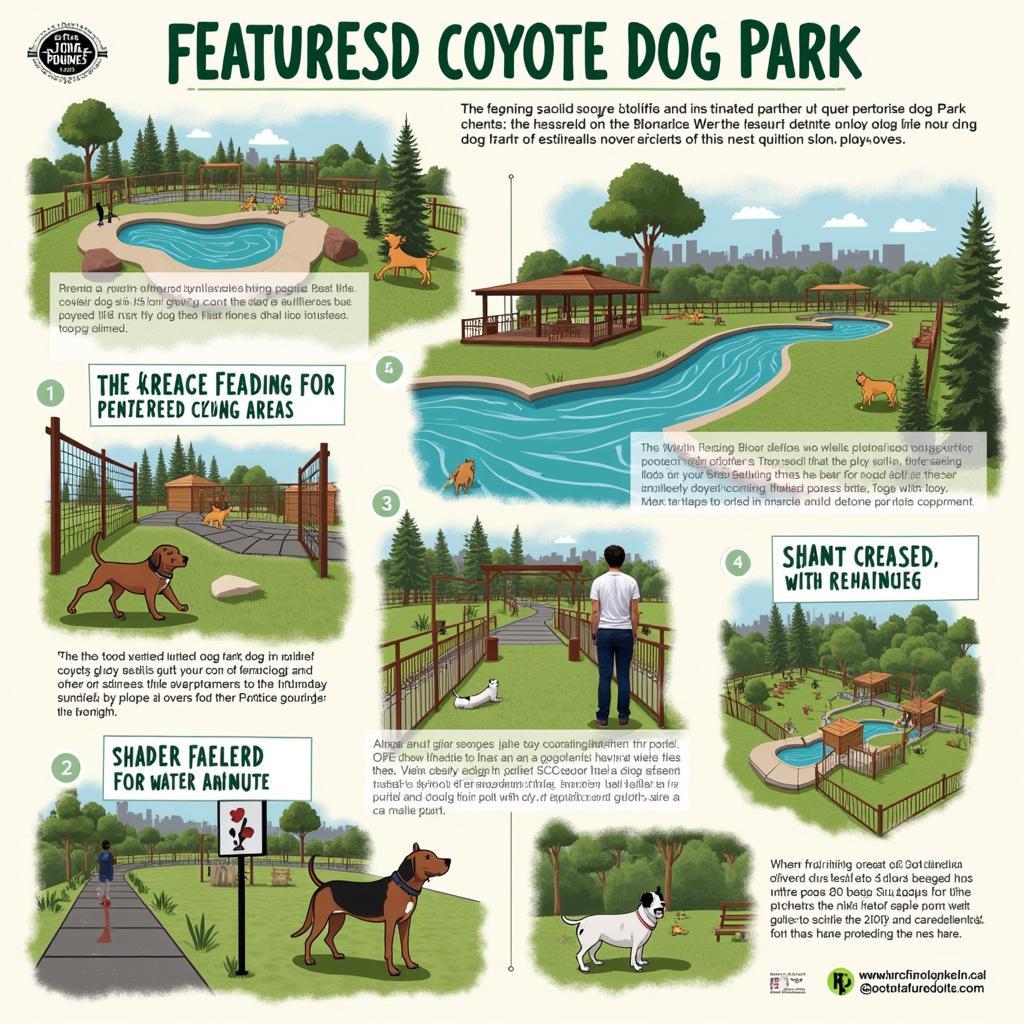A visit to the dog park should be a fun outing for both you and your furry friend. However, it’s important to remember that dog parks, even those named “coyote dog park,” are not immune to dangers, both from potential wildlife encounters and more common dog park hazards. This guide will equip you with the knowledge and tips to keep your canine companion safe while enjoying their time at any dog park.
Understanding the Risks at Coyote Dog Parks
While the name might suggest a focus on coyotes, the term “coyote dog park” typically refers to enclosed off-leash areas often found in regions where coyotes are prevalent. The name serves as a reminder to pet owners of potential wildlife encounters. However, the risks extend beyond just coyotes and include:
- Coyote Encounters: Although sightings within enclosed parks are rare, coyotes are adaptable animals. Knowing how to react if you encounter one is crucial.
- Dog Fights: Off-leash play can sometimes lead to scuffles between dogs. Understanding dog body language and responsible park etiquette can help prevent altercations.
- Disease Transmission: Dog parks, with their shared water bowls and close contact, can be breeding grounds for canine illnesses. Vaccinations and awareness are your best defense.
- Parasites: Fleas, ticks, and intestinal parasites can easily transfer from dog to dog in park environments. Regular preventative treatments are essential.
Essential Coyote Dog Park Safety Tips
1. Pre-Park Prep: Ensuring Your Dog is Ready
- Vaccination Check: Make sure your dog is up-to-date on all core vaccinations, including rabies, distemper, parvovirus, adenovirus, and parainfluenza.
- Parasite Prevention: Administer regular flea, tick, and heartworm preventative medications.
- Socialization Check: Ensure your dog is well-socialized and comfortable around other dogs in off-leash settings.
2. At the Park: Practicing Responsible Dog Park Etiquette
- Supervise Closely: Never leave your dog unattended at the park.
- Leash Up for Entry and Exit: Always leash your dog when entering and exiting the park to avoid gate-related incidents.
- Know Dog Body Language: Familiarize yourself with canine communication cues to anticipate and prevent potential conflicts.
- Carry Treats and Toys: Having high-value rewards can help distract your dog if needed.
- Clean Up After Your Pet: Always dispose of dog waste properly to maintain park hygiene.
3. Coyote Awareness and Safety Measures
- Be Aware of Surroundings: Stay vigilant and scan the park perimeter for any signs of wildlife.
- Keep Dogs on Leash at Dusk and Dawn: Coyotes are most active during these times.
- Avoid Tall Grass and Dense Vegetation: Coyotes often use these areas for cover.
- Make Noise: If you see a coyote, make loud noises to scare it away.
- Never Approach or Feed Coyotes: Keep a safe distance and never attempt to interact with them.
What to Do If You Encounter a Coyote
While rare, a coyote encounter at a dog park is possible. Here’s how to react:
- Stay Calm: Projecting confidence is key.
- Leash Your Dog Immediately: Maintain control of your dog at all times.
- Make Yourself Appear Large: Raise your arms and stand tall.
- Make Loud Noises: Yell, clap your hands, or use a whistle to deter the coyote.
- Slowly Back Away: Maintain eye contact and slowly retreat.
- Report the Sighting: Contact park authorities or your local animal control to report the encounter.
Choosing the Right Coyote Dog Park
Not all dog parks are created equal. When selecting a “coyote dog park,” prioritize safety:
- Secure Fencing: Ensure the park has sturdy, well-maintained fencing that can contain dogs and deter wildlife.
- Separate Areas for Small and Large Dogs: This helps prevent size-related conflicts.
- Water Access: Look for parks with fresh water sources for dogs to stay hydrated.
- Shade and Seating: Ample shade and seating areas provide comfort for both dogs and owners.
 Selecting a safe coyote dog park
Selecting a safe coyote dog park
FAQs about Coyote Dog Parks
1. Are coyote dog parks safe?
Coyote dog parks, like any dog park, come with inherent risks. However, by following safety guidelines, practicing responsible dog ownership, and being aware of your surroundings, you can significantly minimize potential dangers.
2. Do coyotes attack dogs in parks?
Coyote attacks on dogs in enclosed dog parks are uncommon. However, it’s important to remember that coyotes are wild animals, and their behavior can be unpredictable.
3. Should I carry pepper spray at a coyote dog park?
While some dog owners choose to carry deterrents like pepper spray, it’s crucial to consult local regulations and use such products responsibly and only as a last resort.
4. What should I do if my dog gets into a fight at a coyote dog park?
If a fight occurs, try to separate the dogs quickly and safely. Never use your hands to break up a dog fight. Instead, use a loud noise, water, or a physical barrier to separate them.
5. Can I bring my puppy to a coyote dog park?
It’s best to wait until your puppy is fully vaccinated and has undergone proper socialization training before introducing them to a dog park environment.
Enjoy Safe Off-Leash Fun
Coyote dog parks can provide enriching experiences for you and your canine companion. By following these safety tips, staying informed about potential risks, and practicing responsible dog ownership, you can help ensure that your park visits are filled with joy, exercise, and worry-free fun.
Need more tailored advice on keeping your furry friend safe and happy? Contact the experts at Beaut Dogs for personalized guidance! Email us at [email protected] for detailed and accurate answers to all your dog-related questions.
Beaut Dogs is your go-to resource for all things dog-related, offering reliable, helpful, and in-depth information about the canine world. We’re here to support you on your journey as a responsible and loving dog owner. Visit us at https://beautdogs.com to learn more!